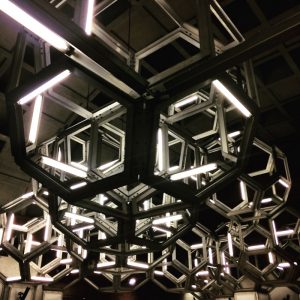Rob Bridgett is an audio director at Eidos-Montréal.
Leonard Paul is the president of the School of Video Game Audio.
Images courtesy of Rob Bridgett & Leonard Paul
Nine years ago, we collaborated on an article on the idea of limitations for Gamasutra and wanted to see where our thoughts would take us. This time around, rather than produce another article, this submission is a set of our musings meant to be used as starting points or inspiration when working with the limitations of game audio.
Allowing a view of the long-term in our art gives a certain freedom but it can also be paralyzing unless we set limits on ourselves.
An exciting, creative challenge is one with well defined limits: a well defined brief; a box to play in.
Not only do technical limits advance but also creative limits as well.
Working within a genre is a form of self-limitation (style and structure, for instance, “we’re going to write a 3 minute pop song”). A platform/format is a limitation: 12 inch, an LP (two sides), a CD (long running playlist). We need to consider the equivalent boxes and structures in games (menu, mission, genre, format, art style).
When working within a corporate environment, the overall emphasis is often on low-risk incremental short-term gains which limits creativity.
Dismiss edge-cases that will never happen and only react to what is in the game. Solve problems that need solving and let the rest fall away.
Balance short-term survival with long-term art.
Limits have become an aesthetic in games. Limbo’s strictly limited aesthetic choices gave us one of the most iconic and creative sound design led approaches.
Deliberately limited aesthetic genres, like chiptune and 8-bit visual fidelity, have become a conscious choice.
Technology has become easier, faster, more limitless; as computers and software become more powerful and sfx libraries become more available and cheaper—deliberate aesthetic limits become more necessary to producing meaningful content.
Small teams can often move faster and are more nimble creatively. See Year Walk, Device 6 & Sailor’s Dream.
A game audio palette not only sets limits on content but on behaviours as well.
The limits that we put on ourselves are often the most difficult limits to break.
Our real limits are our ability to focus our creative abilities and the capacity to capture and engage the attention of our audience.
Self-imposed limits of audio only games, like Papa Sangre, explore new creative spaces.
We are all limited by the length of the project and ultimately by life itself. Avoiding long and crappy projects actually keeps us younger.
Limiting choices reduces time spent prioritizing, switching tasks and producing weaker content that can get in the way of our stronger work.
If we want to cull a lot of our creative output then we need to create an environment that will inspire us to be prolific.
The heart of the expression should shine through the materials and the technical process.
Utilize the limitation of time to quickly sketch ideas and then decide which direction is the strongest to pursue.
Nothing is ever finished. The garden is never done.
Once bounds are set then breaking or bending the rules can help engage the listener, such as using new tone colours or a new process. Many times the adaptive rules are set and can produce poor results that are limited even when the content is rich.
Ask for someone else’s perspective.
Can limits in the sound help to limit the artistic choices elsewhere too?
Work as fast as possible, with the fewest elements. Polishing an entire work can make it stale while some roughness adds a welcome texture.
Consider contrast over consistency.
Can we limit to music only? (no sound, no voice)
Can we limit to voice only? (no sound, no music)
Can we limit to sound only? (no music, no voice)
Can we limit to visual representations of sound only? (no sound, no music, no voice)
What are music, voice and sound? What are their boundaries and limitations?
The whole point of all our creative work is to establish and define the ‘box’ – what does fit in the box vs. what doesn’t. Every single sound made is a validation or rejection of the box. Thinking outside the box is just another way of finding some more material to reject and is really just a way of further defining and underlining the box itself.
It is all useful. Sometimes the most useful aspect of a sound is to remove it once it has served its purpose before reaching the audience.
The sculptural approach: Remove, remove, remove, subtract, subtract everything that isn’t the thing you are trying to make. Sturgeons’s Law applies to everything.
Limitations help remove distraction for the listener. There is a limit on the focus and attention span of the viewer. Engagement is a limited resource.
Focusing the work and reducing elements that cause the audience to be unable to place themselves in the narrative and story arc is important. One sign of a strong piece of art is its ability to engage with a wide audience.
Balancing competing elements is key. Allowing different elements to shine and hold the focus keeps the experience rich and alive. A breath is full and then empty.
A minimal approach is often the reduction of all weaker elements, almost sculptural.
Expressing the experience on screen with the simplest expression. Get a first splat onto the canvass that works… and work from there.
Getting the first expression onto the screen, or into the game, is a desperate race, before everything that inspired it is gone.
All resources are in short supply, time, budget, energy…
A big thank you to Rob and Leonard for this unique and thought-provoking look at the limitations within game audio.






“Limbo’s strictly limited aesthetic choices gave us one of the most iconic and creative sound design led approaches.” – I’ll drink to that!